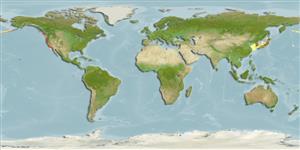>
Perciformes/Scorpaenoidei (Scorpionfishes) >
Sebastidae (Rockfishes, rockcods and thornyheads) > Sebastinae
Etymology: Sebastes: Greek, sebastes = august, venerable (Ref. 45335); mystinus: Name from the Latinized form of the Greek word μυ;stησ, mwhich means initiated one or mystic, c, interpreted by some as 'priest'; 19th century fishermen of Monterey, CA called the fish 'pêche prêtre' because of its dark coloration and its light band between the head bars that resembles a clerical collar (Ref. 103574).
More on authors: Jordan & Gilbert.
Environment: milieu / climate zone / depth range / distribution range
Ecologia
marino associati a barriera corallina; distribuzione batimetrica 0 - 550 m (Ref. 6885), usually 183 - 550 m (Ref. 6885). Subtropical; 45°N - 30°N, 125°W - 115°W
Eastern Pacific: northern limit is uncertain, at least from Vancouver Island in British Columbia, Canada (possibly Aleutian Islands, Alaska) to northern Baja California, Mexico.
Size / Peso / Age
Maturity: Lm ? range ? - ? cm
Max length : 61.0 cm TL maschio/sesso non determinato; (Ref. 40637); peso massimo pubblicato: 3.8 kg (Ref. 40637); Età massima riportata: 44 anni (Ref. 39247)
Short description
Chiavi di identificazione | Morfologia | Morfometria
Spine dorsali (totale) : 13; Raggi dorsali molli (totale) : 15 - 17; Spine anali: 3; Raggi anali molli: 8 - 10; Vertebre: 26 - 27. Head spines weak to very weak - nasals present, preoculars usually present, supraocular, postocular and tympanic spines usually absent, coronal, parietal and nuchal spines absent (Ref. 27437). Eye diameter and mouth small (Ref. 27437). Deep bodied with large pectoral fins (Ref. 27437). Anal fin profile vertical or slanted posteriorly (Ref. 27437). Caudal fin indented (Ref. 6885). Blue or black in color with vague striping on forehead; lighter ventrally (Ref. 27437).
Branchiostegal rays: 7 (Ref. 36715).
May be found near the surface or off the bottom, generally over shallow reefs, but also around kelp and over deep reefs (Ref. 2850). Juveniles are pelagic (Ref. 36715). Form schools, sometimes with other rockfishes (Ref. 2850). Feed mainly on krill (Ref. 2850), but also on tunicates, jellyfishes and fishes (Ref. 6885). Viviparous, with planktonic larvae (Ref. 36715). Young are important prey for fishes and other marine vertebrates (Ref. 2850).
Eschmeyer, W.N., E.S. Herald and H. Hammann, 1983. A field guide to Pacific coast fishes of North America. Boston (MA, USA): Houghton Mifflin Company. xii+336 p. (Ref. 2850)
IUCN Red List Status (Ref. 130435)
Threat to humans
Harmless
Human uses
Pesca: commerciale; Pesce da pesca sportiva: si; Acquario: Acquari pubblici
Strumenti
Special reports
Download XML
Fonti Internet
Estimates based on models
Preferred temperature (Ref.
123201): 0.8 - 7.9, mean 4.2 °C (based on 65 cells).
Phylogenetic diversity index (Ref.
82804): PD
50 = 0.5000 [Uniqueness, from 0.5 = low to 2.0 = high].
Bayesian length-weight: a=0.01000 (0.00499 - 0.02004), b=3.09 (2.92 - 3.26), in cm total length, based on LWR estimates for this Genus-body shape (Ref.
93245).
Trophic level (Ref.
69278): 2.7 ±0.1 se; based on diet studies.
Resilienza (Ref.
120179): Basso, tempo minimo di raddoppiamento della popolazione 4.5 - 14 anni (K=0.17 (?); tm=3-5; tmax=44).
Fishing Vulnerability (Ref.
59153): Moderate to high vulnerability (48 of 100).
Nutrients (Ref.
124155): Calcium = 13.9 [5.0, 45.6] mg/100g; Iron = 0.34 [0.13, 0.81] mg/100g; Protein = 19 [18, 20] %; Omega3 = 0.408 [0.161, 1.050] g/100g; Selenium = 66.4 [22.2, 217.5] μg/100g; VitaminA = 36.5 [11.8, 115.4] μg/100g; Zinc = 0.618 [0.306, 1.205] mg/100g (wet weight);
